Jeff's Visit: Köln
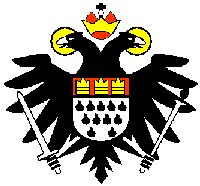
Köln coat of arms
Our journey began after myself and Flo picked up Jeff up from Frankfurt-Hahn airport in an old Mercedes-Benz. Once safely back in Mannheim, we packed up, picked up Irene and proceded to drive to the city of Köln. The drive is about 3-4 hours in total.
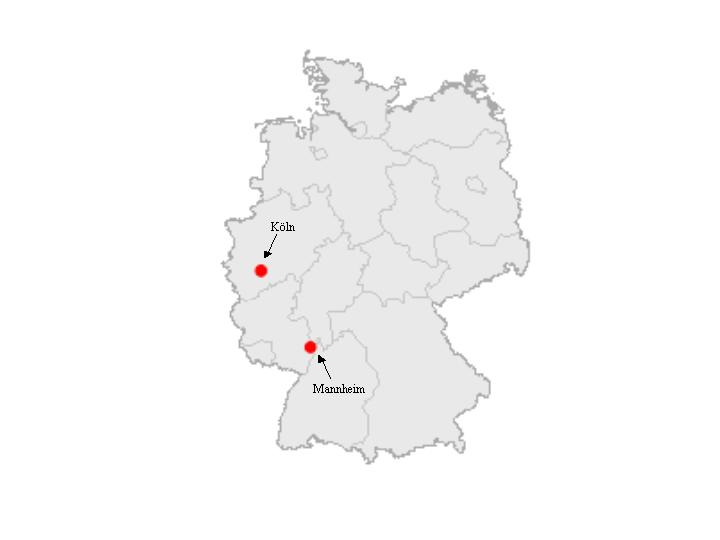
Map of Germany showing Mannheim and Köln.
Köln (pronounced and written as Cologne in English) is a city of approximately 1 million inhabitants, making it the 4th largest city in Germany and the largest in the state of North Rhein-Westphalia. It is situated in the most populous area of Germany, along with other big centers such as Düsseldorf, Dortmund, and Essen. Holding the distinction of being the oldest major city in Germany, it was founded in 39 B.C. by the Romans and the tribe of the Ubii, which had entered into a pact with their Roman conquerors. The population of Köln continued to increase, and by 90 A.D. it was made the capital of the Roman province of Germania Inferior (Lower Germany). By 785, Köln was the seat of an Archbishop, who was one of the Seven Electors of the Holy Roman Empire. The Archbishop ruled a large area as a secular lord, but in 1288, the Archbishop was forced to relocate to Bonn by an uprising of the citizens of Köln, making Köln an unofficial free-city. This status was not recognized until 1475, when Köln became a free governing city, along with my other city-states allied in the Hanseatic League. During the time of Napoleon, the French captured and occupied Köln in 1794, marking the end of its free-status. In 1814, Prussian and Russian forced occupied the city and in 1815 it became part of the Prussian kingdom. The city continued to grow and by the time of WWI, it held over 600,000 residents. During the time of the Thrid Reich, Köln was a source of trouble of the Nazis, due to deep-routed communistic and catholic beliefs. A anti-Nazi youth gang called the Edelweisspiraten was active during WWII times. Unfortunately, the city suffered much devastation during the war, but was fully rebuilt by 1975, when the population reached just over 1 million. To read more about the city of Köln, click here.

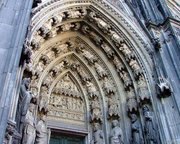
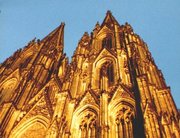
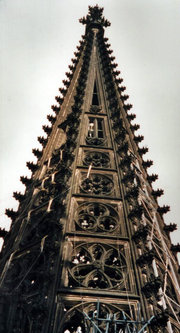
The Köln Cathedral
The most reconizable landmark of Köln is its Cathedral (der Kölner Dom). Construction of the present-day Gothic style church began in the 13th Century, and, with interuptions, took over 600 years to fully complete. It was built to hold the relics of the Magi, taken from Milan by the Holy Roman Emperor, Fredrick Barbarossa and given to the Archbishop of Köln, Rainald von Dassel, in 1164. The most notable of these relics is known as the Sarcophagus of the Magi, a large gilded sarcophagus dating from the 13th century. It is thought to hold the remains of the Three Wise Men. Construction of the Cathedral was slow up until the time of Prussian rule, but finally in 1880, construction was declared complete and the Köln Cathedral became the largest church in Germany and the world's tallest building at this time. The Köln Cathedral suffered 14 direct bomb hits during WWII, but surprizingly did not collapse. Reconstruction was complete in 1956. Today the Cathedral is a World Heritage site. If you wish to read more about the Köln Cathedral, please click here.
Our first impression of Köln was that it was a huge city, and we really had no idea how to get around it other then mundane wandering. It was such then that we found a Youth Hostel in which we could stay. Once settled in, we made our way into the city. On foot, we started to explore Köln, and of course its famous Dom. Later that night it was time to dance and party, and thus our search turned towards clubs, cheap beers, and cheap women (joking about that last). Scroll below to see the pics from our first day in Köln!
Pics from the first day in Köln.

Here is the Rhein river, which also flows through Mannheim further to the South.
|

We were just starting to walk around the city.
|

Our first good look at the Köln Dom.
|

Nice close-up of my face... Thanks Irene...
|

Another shot of the Dom.
|

The Hauptbahnhof (main train station) is directly adjacent to the Dom...
|

Irene, Flo and Jeff on the stairs leading up to the Cathedral.
|

Now we could see some of the amazing stonework that has gone into the creation of this church.
|

It always amazes me how such buildings were created 100's of years ago without the use of our modern day equipment!
|

But on such buildings there is inevitably restoration work to be done. Here you can see the new white portion, and the older non-restored black portion.
|

The various statues and gargoyles must also be repaired. This picture was taken in a "gargoyle-repair" shop!
|

This is the inside of the Dom. You can get an idea at just how massive this building really is...
|

The stained glass windows were really amazing in their intricacy!
|

At all times of the day, services are being held. Even the ghosts sometimes want to listen....
|

Another section of the Dom.
|

As you can see, the Dom is a very busy place...
|

Originally, these windows would have been stained-glass as well. Most likely they were destoyed during WWII, and since the true art of stained-glass is lost, were never replaced... You can see such stories in many of the great cathdrals of Germany, and it always makes me sad...
|

Here is a good example of the stained-glass/normal glass mixture. The top portion of these windows are made from normal glass, while the bottom are the original stained-glass.
|
More pics from Day 1.